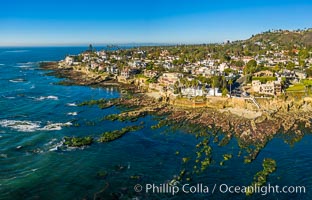
Sun Gold Point Reef Exposed at Extreme Low Tide, La Jolla, California.
Location: La Jolla, California
Image ID: 38012
Location: La Jolla, California
Image ID: 38012
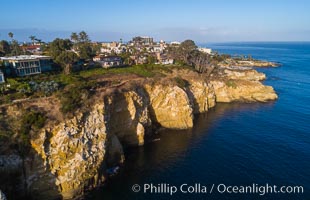
La Jolla Caves and Coastline, Goldfish Point, Aerial Photo.
Location: La Jolla, California
Image ID: 38153
Location: La Jolla, California
Image ID: 38153
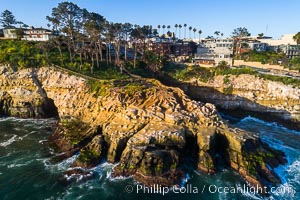
La Jolla Caves and Coastline, Goldfish Point, Aerial Photo.
Location: La Jolla, California
Image ID: 38185
Location: La Jolla, California
Image ID: 38185
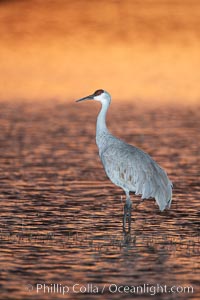
A sandhill crane, standing in still waters with rich gold sunset light reflected around it.
Species: Sandhill crane, Grus canadensis
Location: Bosque del Apache National Wildlife Refuge, Socorro, New Mexico
Image ID: 21805
Species: Sandhill crane, Grus canadensis
Location: Bosque del Apache National Wildlife Refuge, Socorro, New Mexico
Image ID: 21805
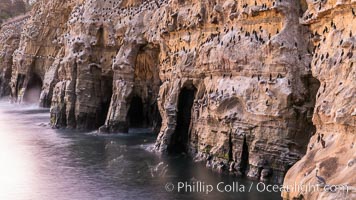
Sea Caves, the famous La Jolla sea caves lie below tall cliffs at Goldfish Point. Sunny Jim Cave. Sunrise.
Location: La Jolla, California
Image ID: 37468
Location: La Jolla, California
Image ID: 37468
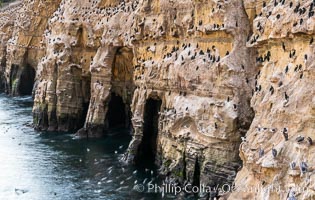
Cormorants resting on sea cliffs above sea caves, the famous La Jolla sea caves lie below tall cliffs at Goldfish Point. Sunny Jim Cave. Sunrise.
Location: La Jolla, California
Image ID: 37472
Location: La Jolla, California
Image ID: 37472
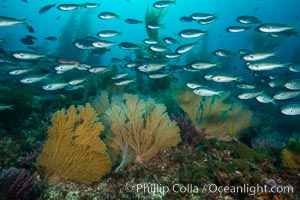
Blacksmith Chromis and California golden gorgonian on underwater rocky reef, San Clemente Island. The golden gorgonian is a filter-feeding temperate colonial species that lives on the rocky bottom at depths between 50 to 200 feet deep. Each individual polyp is a distinct animal, together they secrete calcium that forms the structure of the colony. Gorgonians are oriented at right angles to prevailing water currents to capture plankton drifting by.
Species: Blacksmith, California golden gorgonian, Chromis punctipinnis, Muricea californica
Location: San Clemente Island, California
Image ID: 30891
Species: Blacksmith, California golden gorgonian, Chromis punctipinnis, Muricea californica
Location: San Clemente Island, California
Image ID: 30891
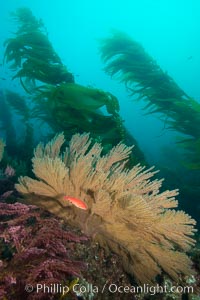
California golden gorgonian and small juvenile sheephead fishes on rocky reef, below kelp forest, underwater. The golden gorgonian is a filter-feeding temperate colonial species that lives on the rocky bottom at depths between 50 to 200 feet deep. Each individual polyp is a distinct animal, together they secrete calcium that forms the structure of the colony. Gorgonians are oriented at right angles to prevailing water currents to capture plankton drifting by.
Species: California sheephead wrasse, Semicossyphus pulcher
Location: San Clemente Island, California
Image ID: 30903
Species: California sheephead wrasse, Semicossyphus pulcher
Location: San Clemente Island, California
Image ID: 30903
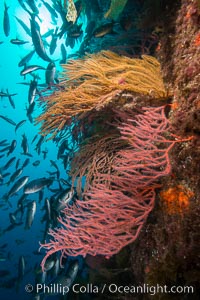
Red gorgonians and California golden gorgonians on rocky reef, below kelp forest, underwater. The red gorgonian is a filter-feeding temperate colonial species that lives on the rocky bottom at depths between 50 to 200 feet deep. Gorgonians are oriented at right angles to prevailing water currents to capture plankton drifting by.
Species: Blacksmith, California golden gorgonian, Red gorgonian, Chromis punctipinnis, Leptogorgia chilensis, Lophogorgia chilensis, Muricea californica
Location: San Clemente Island, California
Image ID: 30914
Species: Blacksmith, California golden gorgonian, Red gorgonian, Chromis punctipinnis, Leptogorgia chilensis, Lophogorgia chilensis, Muricea californica
Location: San Clemente Island, California
Image ID: 30914
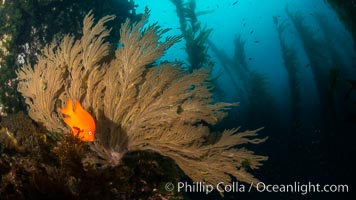
Garibaldi and California golden gorgonian on underwater rocky reef, San Clemente Island. The golden gorgonian is a filter-feeding temperate colonial species that lives on the rocky bottom at depths between 50 to 200 feet deep. Each individual polyp is a distinct animal, together they secrete calcium that forms the structure of the colony. Gorgonians are oriented at right angles to prevailing water currents to capture plankton drifting by.
Species: California golden gorgonian, Garibaldi, Hypsypops rubicundus, Muricea californica
Location: San Clemente Island, California
Image ID: 30923
Species: California golden gorgonian, Garibaldi, Hypsypops rubicundus, Muricea californica
Location: San Clemente Island, California
Image ID: 30923
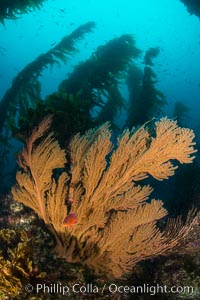
California golden gorgonian on underwater rocky reef below kelp forest, San Clemente Island. The golden gorgonian is a filter-feeding temperate colonial species that lives on the rocky bottom at depths between 50 to 200 feet deep. Each individual polyp is a distinct animal, together they secrete calcium that forms the structure of the colony. Gorgonians are oriented at right angles to prevailing water currents to capture plankton drifting by, San Clemente Island. The golden gorgonian is a filter-feeding temperate colonial species that lives on the rocky bottom at depths between 50 to 200 feet deep. Each individual polyp is a distinct animal, together they secrete calcium that forms the structure of the colony. Gorgonians are oriented at right angles to prevailing water currents to capture plankton drifting by.
Species: California golden gorgonian, Muricea californica
Location: San Clemente Island, California
Image ID: 30928
Species: California golden gorgonian, Muricea californica
Location: San Clemente Island, California
Image ID: 30928
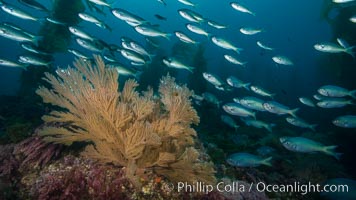
Blacksmith Chromis and California golden gorgonian on underwater rocky reef, San Clemente Island. The golden gorgonian is a filter-feeding temperate colonial species that lives on the rocky bottom at depths between 50 to 200 feet deep. Each individual polyp is a distinct animal, together they secrete calcium that forms the structure of the colony. Gorgonians are oriented at right angles to prevailing water currents to capture plankton drifting by.
Species: Blacksmith, California golden gorgonian, Chromis punctipinnis, Muricea californica
Location: San Clemente Island, California
Image ID: 30895
Species: Blacksmith, California golden gorgonian, Chromis punctipinnis, Muricea californica
Location: San Clemente Island, California
Image ID: 30895
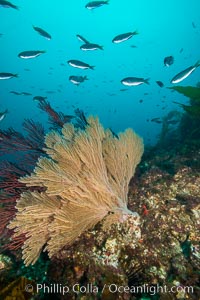
California golden gorgonian on underwater rocky reef, San Clemente Island. The golden gorgonian is a filter-feeding temperate colonial species that lives on the rocky bottom at depths between 50 to 200 feet deep. Each individual polyp is a distinct animal, together they secrete calcium that forms the structure of the colony. Gorgonians are oriented at right angles to prevailing water currents to capture plankton drifting by.
Species: California golden gorgonian, Muricea californica
Location: San Clemente Island, California
Image ID: 30900
Species: California golden gorgonian, Muricea californica
Location: San Clemente Island, California
Image ID: 30900
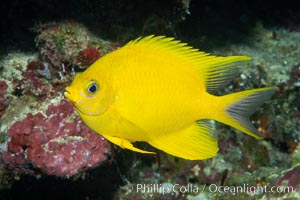
Golden Damselfish, Fiji.
Species: Golden damselfish, Amblyglyphidodon aureus
Location: Namena Marine Reserve, Namena Island, Fiji
Image ID: 34999
Species: Golden damselfish, Amblyglyphidodon aureus
Location: Namena Marine Reserve, Namena Island, Fiji
Image ID: 34999
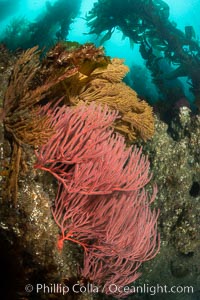
Red gorgonian and California golden gorgonian on underwater rocky reef below kelp forest, San Clemente Island. Gorgonians are filter-feeding temperate colonial species that lives on the rocky bottom at depths between 50 to 200 feet deep. Each individual polyp is a distinct animal, together they secrete calcium that forms the structure of the colony. Gorgonians are oriented at right angles to prevailing water currents to capture plankton drifting by, San Clemente Island. Gorgonians are oriented at right angles to prevailing water currents to capture plankton drifting by.
Species: Red gorgonian, Leptogorgia chilensis, Lophogorgia chilensis
Location: San Clemente Island, California
Image ID: 37059
Species: Red gorgonian, Leptogorgia chilensis, Lophogorgia chilensis
Location: San Clemente Island, California
Image ID: 37059
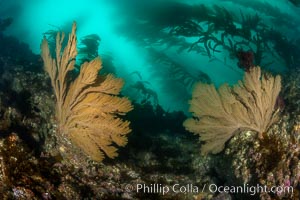
California golden gorgonian on underwater rocky reef below kelp forest, San Clemente Island. The golden gorgonian is a filter-feeding temperate colonial species that lives on the rocky bottom at depths between 50 to 200 feet deep. Each individual polyp is a distinct animal, together they secrete calcium that forms the structure of the colony. Gorgonians are oriented at right angles to prevailing water currents to capture plankton drifting by.
Species: California golden gorgonian, Muricea californica
Location: San Clemente Island, California
Image ID: 37078
Species: California golden gorgonian, Muricea californica
Location: San Clemente Island, California
Image ID: 37078
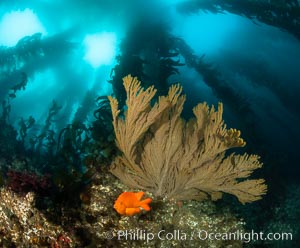
Garibaldi and golden gorgonian, with a underwater forest of giant kelp rising in the background, underwater.
Species: California golden gorgonian, Garibaldi, Hypsypops rubicundus, Muricea californica
Location: San Clemente Island, California
Image ID: 37094
Species: California golden gorgonian, Garibaldi, Hypsypops rubicundus, Muricea californica
Location: San Clemente Island, California
Image ID: 37094
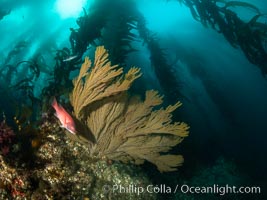
California golden gorgonian and small juvenile sheephead fishes on rocky reef, below kelp forest, underwater. The golden gorgonian is a filter-feeding temperate colonial species that lives on the rocky bottom at depths between 50 to 200 feet deep. Each individual polyp is a distinct animal, together they secrete calcium that forms the structure of the colony. Gorgonians are oriented at right angles to prevailing water currents to capture plankton drifting by.
Species: California golden gorgonian, Muricea californica
Location: San Clemente Island, California
Image ID: 37095
Species: California golden gorgonian, Muricea californica
Location: San Clemente Island, California
Image ID: 37095
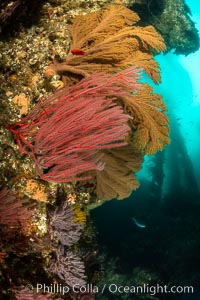
Red gorgonian and California golden gorgonian on underwater rocky reef below kelp forest, San Clemente Island. Gorgonians are filter-feeding temperate colonial species that lives on the rocky bottom at depths between 50 to 200 feet deep. Each individual polyp is a distinct animal, together they secrete calcium that forms the structure of the colony. Gorgonians are oriented at right angles to prevailing water currents to capture plankton drifting by, San Clemente Island. Gorgonians are oriented at right angles to prevailing water currents to capture plankton drifting by.
Species: Red gorgonian, Leptogorgia chilensis, Lophogorgia chilensis
Location: San Clemente Island, California
Image ID: 37116
Species: Red gorgonian, Leptogorgia chilensis, Lophogorgia chilensis
Location: San Clemente Island, California
Image ID: 37116
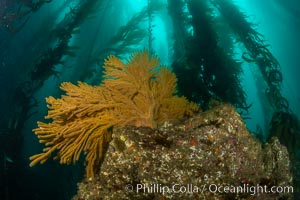
California golden gorgonian on underwater rocky reef below kelp forest, San Clemente Island. The golden gorgonian is a filter-feeding temperate colonial species that lives on the rocky bottom at depths between 50 to 200 feet deep. Each individual polyp is a distinct animal, together they secrete calcium that forms the structure of the colony. Gorgonians are oriented at right angles to prevailing water currents to capture plankton drifting by.
Species: California golden gorgonian, Muricea californica
Location: San Clemente Island, California
Image ID: 37118
Species: California golden gorgonian, Muricea californica
Location: San Clemente Island, California
Image ID: 37118
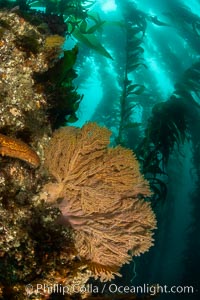
California golden gorgonian on underwater rocky reef below kelp forest, San Clemente Island. The golden gorgonian is a filter-feeding temperate colonial species that lives on the rocky bottom at depths between 50 to 200 feet deep. Each individual polyp is a distinct animal, together they secrete calcium that forms the structure of the colony. Gorgonians are oriented at right angles to prevailing water currents to capture plankton drifting by.
Species: California golden gorgonian, Muricea californica
Location: San Clemente Island, California
Image ID: 37119
Species: California golden gorgonian, Muricea californica
Location: San Clemente Island, California
Image ID: 37119
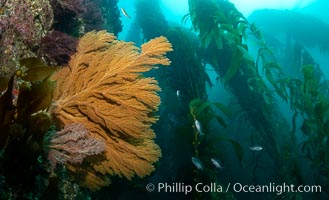
Golden gorgonian on underwater rocky reef, amid kelp forest, near Eagle Rock, Catalina Island. The golden gorgonian is a filter-feeding temperate colonial species that lives on the rocky bottom at depths between 50 to 200 feet deep. Each individual polyp is a distinct animal, together they secrete calcium that forms the structure of the colony. Gorgonians are oriented at right angles to prevailing water currents to capture plankton drifting by.
Image ID: 37135
Image ID: 37135
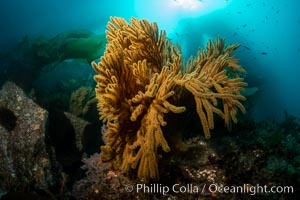
Golden gorgonian on underwater rocky reef, amid kelp forest, Catalina Island. The golden gorgonian is a filter-feeding temperate colonial species that lives on the rocky bottom at depths between 50 to 200 feet deep. Each individual polyp is a distinct animal, together they secrete calcium that forms the structure of the colony. Gorgonians are oriented at right angles to prevailing water currents to capture plankton drifting by.
Location: Catalina Island, California
Image ID: 37155
Location: Catalina Island, California
Image ID: 37155
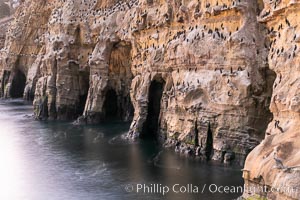
Sea Caves, the famous La Jolla sea caves lie below tall cliffs at Goldfish Point. Sunny Jim Cave. Sunrise.
Location: La Jolla, California
Image ID: 37467
Location: La Jolla, California
Image ID: 37467
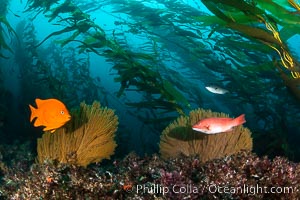
Garibaldi, juvenile sheephead and California golden gorgonian on underwater rocky reef, San Clemente Island. The golden gorgonian is a filter-feeding temperate colonial species that lives on the rocky bottom at depths between 50 to 200 feet deep. Each individual polyp is a distinct animal, together they secrete calcium that forms the structure of the colony. Gorgonians are oriented at right angles to prevailing water currents to capture plankton drifting by.
Species: California golden gorgonian, Giant kelp, Garibaldi, Muricea californica, Macrocystis pyrifera, Hypsypops rubicundus
Location: San Clemente Island, California
Image ID: 38522
Species: California golden gorgonian, Giant kelp, Garibaldi, Muricea californica, Macrocystis pyrifera, Hypsypops rubicundus
Location: San Clemente Island, California
Image ID: 38522
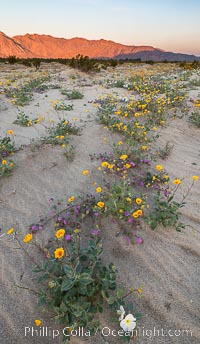
Desert Gold Wildflowers Spring Bloom in Anza-Borrego.
Species: Desert gold, Dune evening primrose, Sand verbena, Abronia villosa, Geraea canescens, Oenothera deltoides
Location: Anza-Borrego Desert State Park, Borrego Springs, California
Image ID: 30535
Species: Desert gold, Dune evening primrose, Sand verbena, Abronia villosa, Geraea canescens, Oenothera deltoides
Location: Anza-Borrego Desert State Park, Borrego Springs, California
Image ID: 30535
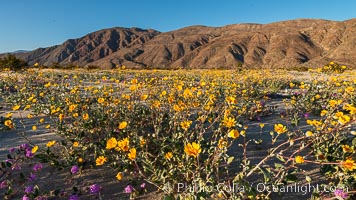
Desert Gold Wildflowers Spring Bloom in Anza-Borrego.
Species: Desert gold, Geraea canescens
Location: Anza-Borrego Desert State Park, Borrego Springs, California
Image ID: 30548
Species: Desert gold, Geraea canescens
Location: Anza-Borrego Desert State Park, Borrego Springs, California
Image ID: 30548
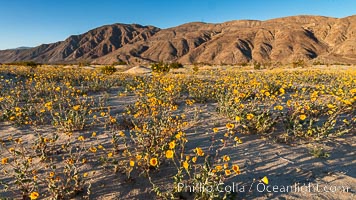
Desert Gold Wildflowers Spring Bloom in Anza-Borrego.
Species: Desert gold, Geraea canescens
Location: Anza-Borrego Desert State Park, Borrego Springs, California
Image ID: 30550
Species: Desert gold, Geraea canescens
Location: Anza-Borrego Desert State Park, Borrego Springs, California
Image ID: 30550
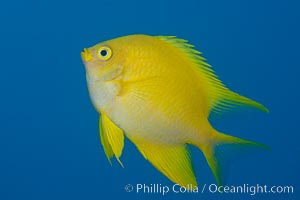
Golden Damselfish, Fiji.
Species: Golden damselfish, Amblyglyphidodon aureus
Location: Makogai Island, Lomaiviti Archipelago, Fiji
Image ID: 31777
Species: Golden damselfish, Amblyglyphidodon aureus
Location: Makogai Island, Lomaiviti Archipelago, Fiji
Image ID: 31777
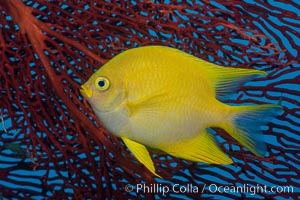
Golden Damselfish and Red Gorgonian Sea Fan, Fiji.
Species: Golden damselfish, Gorgonian, Sea fan, Amblyglyphidodon aureus, Gorgonacea, Plexauridae
Location: Makogai Island, Lomaiviti Archipelago, Fiji
Image ID: 31778
Species: Golden damselfish, Gorgonian, Sea fan, Amblyglyphidodon aureus, Gorgonacea, Plexauridae
Location: Makogai Island, Lomaiviti Archipelago, Fiji
Image ID: 31778